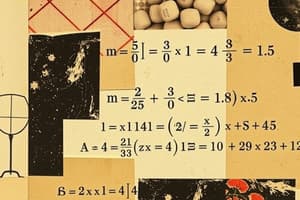Podcast
Questions and Answers
What is the common difference in the arithmetic sequence {4, 7, 10, 13,...}?
What is the common difference in the arithmetic sequence {4, 7, 10, 13,...}?
- 3 (correct)
- 5
- 2
- 4
In a geometric sequence, each term is found by adding a constant to the previous term.
In a geometric sequence, each term is found by adding a constant to the previous term.
False (B)
Calculate the 5th term of the arithmetic sequence where the first term is 2 and the common difference is 4.
Calculate the 5th term of the arithmetic sequence where the first term is 2 and the common difference is 4.
18
The ______ ratio in the geometric sequence {2, 6, 18, 54,...} is 3.
The ______ ratio in the geometric sequence {2, 6, 18, 54,...} is 3.
Match the following sequences to their formulas:
Match the following sequences to their formulas:
Flashcards are hidden until you start studying
Study Notes
Word Problems
- Understand the problem by identifying key information.
- Look for keywords:
- Addition: "increased by," "total," "combined."
- Subtraction: "less than," "remaining," "difference."
- Translate the problem into a mathematical expression.
- Solve the equation step by step, ensuring clarity.
- Check the solution in the context of the problem.
Place Value Understanding
- Recognize the value of each digit in a 5-digit number:
- Ten-thousands (10,000)
- Thousands (1,000)
- Hundreds (100)
- Tens (10)
- Units (1)
- Understand how place value affects addition and subtraction operations.
- Maintain alignment of numbers based on their place values when performing calculations.
Regrouping Techniques
- Regrouping (or carrying/borrowing) is necessary when:
- The digit in the sum exceeds 9 (for addition).
- Subtracting a larger digit from a smaller one (for subtraction).
- Steps for Addition:
- Add digits from rightmost (unit) to leftmost (ten-thousands).
- If the sum is 10 or more, carry over to the next left column.
- Steps for Subtraction:
- Start subtracting from the rightmost side.
- If the top digit is smaller, borrow from the next left digit.
Adding and Subtracting Numbers Grade 6
- Addition Example:
- Align numbers based on place value.
- Perform vertical addition, carrying over when necessary.
- Subtraction Example:
- Align numbers similarly.
- Use regrouping as needed; borrow from the left if necessary.
- Practice is essential for mastering these techniques—use various problems to reinforce understanding.
Solving Word Problems
- Identify key information in word problems.
- Look for keywords:
- Addition: "increased by", "total", "combined".
- Subtraction: "less than", "remaining", "difference".
- Convert word problems into mathematical expressions.
- Solve equations step-by-step, ensuring clarity.
- Check your solution in the context of the original problem.
Place Value Understanding
- Understand the value of each digit in a 5-digit number:
- Ten-thousands (10,000)
- Thousands (1,000)
- Hundreds (100)
- Tens (10)
- Units (1)
- Place value affects addition and subtraction operations.
- Align numbers based on place values when performing calculations.
Regrouping in Addition and Subtraction
- Regrouping (carrying/borrowing) is necessary when:
- The sum of digits is 10 or more (addition).
- Subtracting a larger digit from a smaller one (subtraction).
Regrouping Techniques in Addition
- Start adding from the rightmost (unit) to leftmost (ten-thousands) digit.
- If the sum of digits exceeds 9, carry over 1 to the next left digit.
Regrouping Techniques in Subtraction
- Start subtracting from the rightmost digit.
- If the top digit is smaller than the bottom digit, borrow 1 from the next left digit.
Adding and Subtracting Numbers in Grade 6
- Addition Example:
- Align numbers vertically based on place value.
- Perform addition, carrying over when necessary.
- Subtraction Example:
- Align numbers vertically based on place value.
- Use regrouping as needed, borrowing from the left digit when necessary.
- Practice is key to mastering these techniques, use various problems to reinforce understanding.
Place Value Understanding
- Each digit in a number holds a value based on its position.
- In a 5-digit number, each digit represents ten-thousands, thousands, hundreds, tens, and units (ones).
- The number 34,567 has a 3 in the ten-thousands place, a 4 in the thousands place, a 5 in the hundreds place, a 6 in the tens place, and a 7 in the units place.
Word Problems
- To solve a word problem, carefully read and understand the question.
- Identify the key information, including numbers and operations needed.
- Convert the word problem into a numerical equation.
- Perform addition or subtraction to solve the equation.
- Verify if the answer makes sense in the context of the problem.
- For instance, in the example, "A town has 12,345 residents. If 3,456 move away, how many residents remain?", the equation is 12,345 - 3,456 = 8,889.
Regrouping Techniques
- Regrouping involves carrying over or borrowing when adding or subtracting.
- When adding, if the sum of a column exceeds 10, carry the ten over to the next column.
- For example, in 27,568 + 14,679, carry the ten over to the next column when adding.
- When subtracting, if a digit in the top number is smaller than the corresponding digit in the bottom number, borrow from the next column.
- For example, in 53,215 - 18,679, borrow from the tens to subtract from the ones.
Adding and Subtracting Numbers (Grade 6)
- Align numbers by place value.
- Add or subtract each column starting from the right.
- Utilize regrouping when necessary.
- Practice exercises involving 5-digit numbers to solidify skills in addition and subtraction.
Arithmetic Sequences
- A sequence where the difference between consecutive terms is constant.
- The general formula to find the
nthterm is:a_n = a_1 + (n-1)da_n: the nth terma_1: the first termd: the common differencen: the term number
Geometric Sequences
- A sequence where each term is found by multiplying the previous term by a constant (common ratio).
- The general formula to find the
nthterm is:a_n = a_1 × r^(n-1)a_n: the nth terma_1: the first termr: the common ration: the term number
Key Concepts
- Both arithmetic and geometric sequences can be extended indefinitely using their formulas.
- Understanding the pattern of differences in an arithmetic sequence and the pattern of ratios in a geometric sequence is crucial to complete these sequences.
- Problems can involve finding specific terms in the sequence or identifying missing values.
Studying That Suits You
Use AI to generate personalized quizzes and flashcards to suit your learning preferences.




